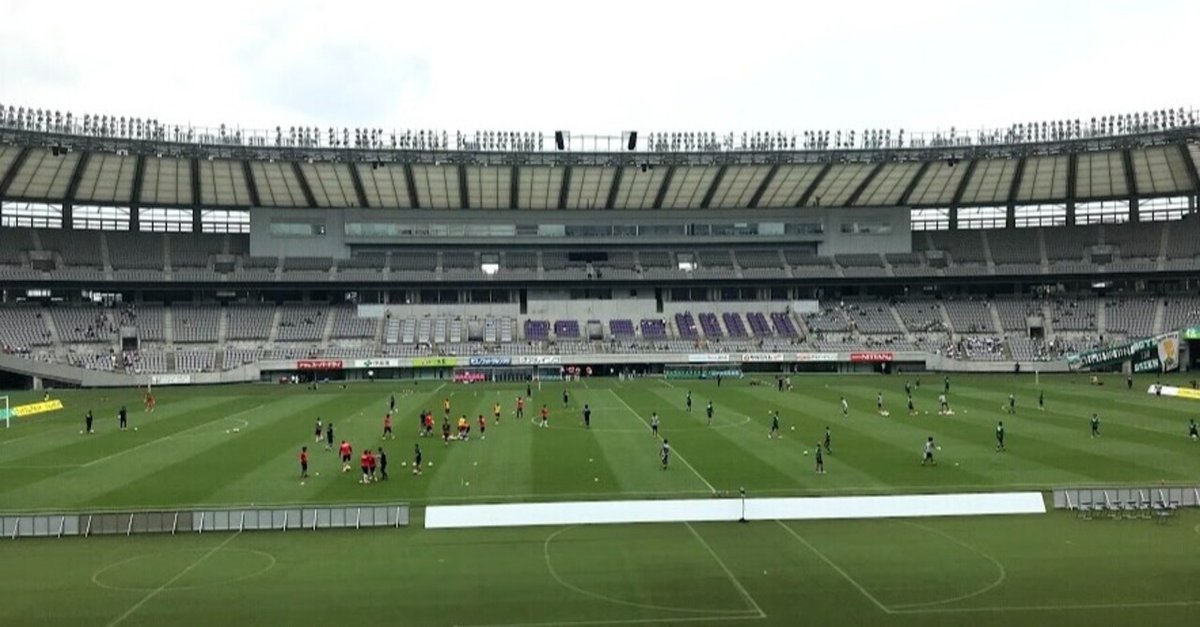
Tactical terms:戦術用語[日本語訳]その1
皆さんこんにちは、Ryu-Yです。
本記事は、jadamsftblより「Tactical teams」の日本語訳その1になります。
非常に長いので2回に分けています。
画像、GIFは全て下記サイトより引用しています。
Tactical terms - 戦術用語
Access:アクセス
Access has different connotations depending on whether a team has possession or not.
アクセスはボール保時と非保持で異なる意味合いを持つ。
In possession: whether or not a team can find a player or space with the ball. E.g. a team might struggle to access their full back in the initial build-up stage because the opposition’s winger presses the centre back whilst keeping the full back in his cover shadow.
ボール保持:チームとしてボールを持ちながら味方やスペースを見つけられるかどうか。例えば、相手のウイングの選手がボールを持つセンターバックの選手にプレッシャーをかける時にカバーシャドウの動きをしている為、じチームは自陣でのビルドアップの段階でセンターバックにアクセスするのに苦労しているのかもしれない。
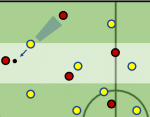
Out of possession: whether or not a team can defend a player, space or the ball. E.g. the defending team has poor access to the opposition’s striker dropping between the lines – this is because the whole back line is pinned by the wingers coming inside, and the two central midfielders are too man-orientated.
ボール非保持:チームとして選手、スペース、ボールを守ることが出来るかどうか。例えば、ボール非保持のチームは相手のストライカーがライン間に下りてきた時アクセスが悪くなる。なぜなら、そのタイミングで相手ウインガーは内側に移動し、ディフェンスの選手はピン留めされるからである。
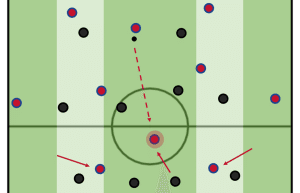
Ball-orientation:ボールオリエンテーション
Ball-orientation is a term used to describe when the ball is the primary reference point for players’ positioning. This can apply both in and out of possession. In possession, this would mean that players provide lots of support near the ball, creating short passing options. The purpose of this is to provoke the opponent to press, which creates gaps to be exploited through short passes. Teams who are ball-orientated in possession often use the ‘overload to isolate’ and ‘up-back-through’ attacking mechanisms.
ボールオリエンテーションはボールが選手のポジショニングの主な基準点となる場合に用いられる用語である。これはボール保持、非保持の両方に当てはまる。ボール保持ではボールの近くで多くのサポートを提供し、短いパスコースを作り出すことを意味する。これは相手のプレスを誘発し、ショートパスによって隙を作り、それを利用することを目的としている。ボール保持を志向するチームは「孤立させるためのオーバーロード」や「アップバックスルー」といった攻撃メカニズムをしばしば利用する。
Out of possession, ball-orientated teams look to apply heavy pressure on the ball and its surrounding areas. Although ball-orientated defending can be effective at regaining possession, the sometimes extreme compactness can lead to big spaces being left open to be exploited by a switch.
ボール非保持では、チームとしてボールやその周辺のエリアに強いプレッシャーをかける。ボールを中心としたディフェンスはボール奪回に効果的であるが、時々背後に大きなスペースを空けたままスイッチを入れプレッシャーをかけることもある。
Napoli being Napoli... they've got the sauce pic.twitter.com/Erwc3LzaHr
— Jamie (@jadamsftbl) August 9, 2017
Between the lines:ライン間
A player who is ‘between the lines’ occupies the space between the opponent’s midfield and defensive lines. Players who consistently receive the ball between the lines are dangerous. They occupy positions where it is more possible to play passes in behind the defence (the most dangerous type of pass). Being between players on different lines forces the opposing defender(s) into a decisional crisis – mark/provoke the player and risk leaving space in behind or leave the player unmarked and allow them to turn?
「ライン間」にいる選手は相手の中盤とディフェンスラインの間のスペースに位置している。常にライン間でボールを受ける選手は危険である。その選手はディフェンスラインの背後にパスを出すことが可能な位置にいることになる(最も危険なパス)。異なるライン上の選手たちの間に立つことで、相手ディフェンダーはライン間にいる選手に付いていくべきか否か決断を迫られることになる。

Blind side:死角
A player who is on the ‘blind side’ of a defender is in a position where the defender cannot see them without turning their head. If the defender does turn their head to see the player, they can no longer focus on the ball. Being positioned on or running onto the blind side of a defender is advantageous for attackers because defending players have to focus on the ball and thus often cannot react in time to adjust to blind side movement.
ディフェンダーにとって「死角」にいる選手は、首を振らないと見ることは出来ない。もしディフェンダーが首を振ると、ボールに集中出来なくなる。ディフェンダーの死角にいることや死角に走り込むことは攻撃側に有利になる。それはディフェンスの選手はボールに集中しなければならず、死角からの動きにすぐ反応出来ないことが多い為である。
#mufc 2nd ⚽️ was a work of art:
— Jamie (@jadamsftbl) September 10, 2017
• Lukaku living on the blindside
• Committing defenders w/ the ball
• Width to open gaps between defenders pic.twitter.com/7p2DUjzQF9
Block:ブロック
The word ‘block’ is used to describe a team’s compact defensive shape, and is characteristed by the height of the defensive line. For example, a high block team will typically hold a compact shape with the defensive line positioned around the halfway line, looking to press high up the pitch. A medium block team will typically hold a compact shape with the defensive line positioned in between the halfway line and their own penalty box. A low block team will typically hold a compact shape with the defensive line positioned around the edge of their own penalty area.
「ブロック」という言葉はチームとしてコンパクトな守備陣形を表現する時に用いられ、ディフェンスラインの高さによって特徴付けられる。例えば高い位置でブロックを敷くチームは通常ハーフウェーライン付近に位置し、ピッチの高い位置でプレスをかける。中間ブロックを敷くチームは大抵ハーフウェーラインと自陣ペナルティエリアの間に位置する。低いブロックを敷くチームは通常ペナルティエリア端に位置し、コンパクトな陣形を保つ。
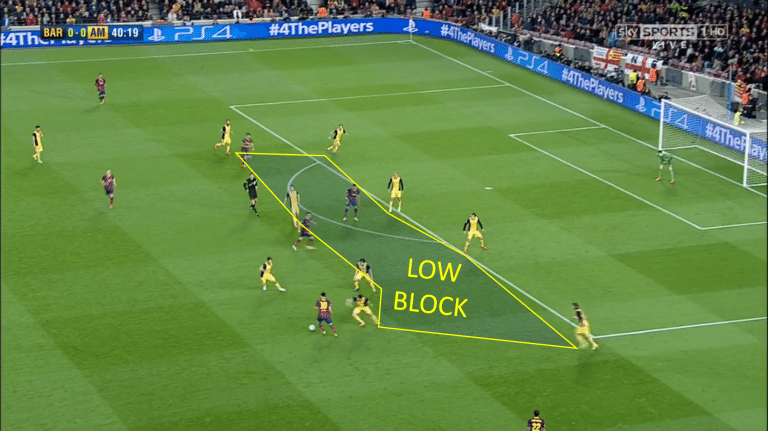
Bounce pass / wall pass:バウンスパス/壁パス
A pass to a player, usually under pressure, who uses a one-touch pass to find a spare player who could not previously be accessed. Bounce passes are a good way of beating the first line of pressure to find someone who can face forward and carry the ball into empty space.
これは通常プレッシャーがかかっている中で行うパスで、そのままでは届かない選手にワンタッチでもう一人の選手を見つけるパスである。バウンスパスは相手の最初のラインのプレッシャーに打ち勝ち、前を向いてボールを空いているスペースに運ぶ選手を見つけるのに有効な方法である。
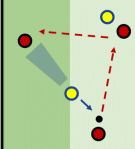
Breaking lines:ライン突破
A pass that ‘breaks the lines’ travels from in front of the opponent’s midfield line to in between the opponent’s midfield and defensive lines. Breaking lines is extremely valuable as it progresses the ball into an area where it is more possible to directly attack the defensive line (and subsequently the goal).
「ライン突破」のパスとは相手の中盤の前から相手の中盤とディフェンスラインを通すパスである。ライン突破することはディフェンスラインに対して直接攻撃することが可能なエリアにボールを運ぶことが出来る為、非常に価値の高いものである。

Channel:チャンネル
A channel is the space between two or more players. Use of the word channel typically revolves around the vertical space between two players. ‘Pumping it down the channel’, for instance, would refer to a long ball played between the centre-back and full-back. It can also be used to describe the horizontal space between two players, which is usually referred to as the space ‘between the lines’ (see above).
チャンネルとは2人以上の選手の間の空間のことである。チャンネルという言葉に使用は、通常2人の選手の垂直方向のスペースを中心に展開される。例えば「チャンネル下にポンピングする」はセンターバックとサイドバックの間にロングボールを入れ込むことである。また、2人の水平方向の空間を表現するのにも使われることがあるが、通常それは「ライン間」と呼ばれる(上述)。
Chain:チェーン
When defending, the defensive and midfield lines work like a chain and each player acts as a chain link. When one player moves, the rest of the line has to move to ensure the line stays connected. This movement looks like a chain reaction, hence the term. An example would be a ‘four-chain midfield’.
守備時、ディフェンスラインと中盤が鎖のように動き、各選手たちが連鎖的に役割を果たす。一人の選手が動けば他の選手も動き、ラインが繋がったままであることを確実にしなければならない。この動きは連鎖反応のように見えるのでこの言葉が使われる。例としては「4連鎖の中盤」が挙げられる。
Collapsing:コラプシング
Collapsing refers to the collective movement of a group of players to put pressure on the ball and/or to protect space in reaction to a pass or dribble that is made inside the defending team’s shape. Teams usually ‘collapse’ in response to a line-breaking pass or during the transition to defence in order to protect the deeper spaces. Central pressing traps are dependent on players collapsing onto the ball when a forward pass is made inside the centre of the team’s defensive shape.
コラプシングとは、守備側の陣形の内側で行われたパスやドリブルに反応してボールにプレッシャーをかけたりスペースを守るための集団的な動きのことである。チームは通常、ラインを突破するパスに反応するか守備ブロックへ移行中に、より深いスペースを守るために「崩れる」ことが多い。中央でのプレスの掛け方は縦パスが守備組織の真ん中で行われた時に選手がボール方向に下りるかどうかで決まる。
Compact / compactness:コンパクト/コンパクトネス
A team with a compact defensive shape features short distances both horizontally and vertically between the farthest players (i.e. horizontally from wing to wing, vertically from defenders to attackers). Optimal compactness could be defined as: individual players are as far away from each other as possible whilst maintaining the connections between each player and having access to the ball.
コンパクトな守備陣形を敷くチームの特徴は、最も遠い選手同士の距離が水平方向、垂直方向共に短いことである(則ち、水平方向とはウインガー同士の距離、垂直方向とはディフェンダーからフォワードへの距離)。最適なコンパクトさは次のように定義される:個々の選手は選手間のつながりを意識し、ボールにアクセス出来るようにしながら互いに可能な限り距離を離すことである。
Compactness has various benefits for the defending team. The high number of connections makes it more difficult for the opponent to penetrate the shape, and if penetration does occur, there are more defending players in the vicinity who can react quickly. Compactness near the ball means having better access to the ball, which ensures that effective pressure can be applied as more players are in positions to press, limit passing options and react to dribbling. Compactness also translates to having better spatial control – the density of players in a compact shape grants a high degree of control over important spaces by technically covering a small area. This often forces opponents into strategically less valuable areas, and the short distances between players ensures quicker reactions to penetration.
コンパクトであることは守備側にとって様々なメリットがある。つながりの数が多いことで相手が陣形の間にボールを通すことが難しくなり、また通過した場合でも素早く対応出来る守備側の選手が近くに多くいることになる。ボールの近くにコンパクトになるということは、ボールへのアクセスが良くなるということであり、より多くの選手がプレスをかけたり、パスの選択肢を制限したり、ドリブルに反応したりする位置にいる為、効果的なプレッシャーをかけることが出来る。コンパクトな陣形の中での選手の密度を高めることで技術的に狭いエリアをカバーし、重要なスペースを高度にコントロールすることが可能である。これにより相手はあまり有効でないエリアに追い込まれてしまうことが多く、選手間の距離が短い為守備組織への侵入に対して反応が早くなる。
This comprehensive piece on compactness from the Spielverlagerung crew is very informative.
Spielverlagerungスタッフによるコンパクトさに関する分かりやすい画像は非常に参考になる。

Counter-pressing:カウンタープレッシング
A literal translation of the German word ‘gegenpressing’. To counter-press means to press against the ball immediately after losing possession. Different types of counter-pressing are characterized by the goal of the pressing (i.e. to force long balls or to regain the ball high) and the orientation of the players (man / space / ball / passing lanes).
ドイツ語の「ゲーゲンプレッシング」を英訳したものである。カウンタープレスとはボールを失った直後にボールに対してプレスをかけることである。カウンタープレスの種類は、プレスの目的(ロングボールを蹴らせたいのか高い位置で奪い返したいのか)や選手の方向(人、スペース、ボール、パスコース)によって特徴が異なる。
While counter-pressing is viewed primarily as a defensive action, it also provides attacking benefits. Balls recovered through counter-pressing are typically closer to the opponent’s goal, and the opponent is usually unbalanced as they are transitioning to attack. The proximity to goal and open spaces can lead to high quality chances. Jurgen Klopp: “no playmaker in the world can be as good as a good counter-pressing situation”.
カウンタープレスは守備的な動作として捉えられているが攻撃的な効果もある。カウンタープレスによって回収されたボールは、通常相手ゴールに近く相手は攻撃へと移行する際にポジショニングを崩していることが多い。ゴールまで近いこととオープンスペースがあることで質の高いチャンスを生み出すことが出来る。ユルゲン・クロップ監督曰く「良いカウンタープレッシングの状況ほど優れたプレーメーカーはいない。」
Cover shadow:カバーシャドウ
A cover shadow is the area covered directly behind a defending player. Cover shadows are a useful defensive mechanism because they allow defending players to simultaneously press the ball carrier while cutting off a passing lane, because it is difficult to play a pass directly behind a player.
カバーシャドウとはディフェンダーの真後ろにカバーされているエリアのことである。カバーシャドウ時はディフェンダーの真後ろでパスをさばくことが難しく、またパスコースを消しながらボールホルダーに対してプレッシャーをかけることが出来る為、有効なディフェンスの仕組みとなっている。
A nice way to think of it is, ‘the closer a defending player gets to the ball, the bigger their shadow’. There are a few ways to beat cover shadows – namely through dribbling, passing around or over the defending player (bounce passes are common), or the covered player moving out of the cover shadow to receive.
良い意味で、ディフェンダーがボールに近づけば近づくほどカバーシャドウの範囲は大きくなる。カバーシャドウを破る方法は幾つかある-ドリブル、ディフェンダーの周囲や上空を通るパス(バウンスパスが一般的である)、カバーされた選手がそのエリアの外に出てパスを受ける方法である。
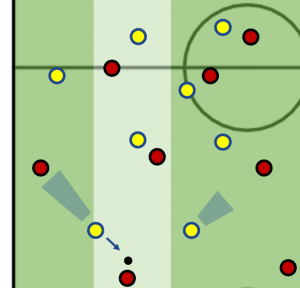
Free man / spare man:フリーマン/スペアマン
A player who is unmarked in space, typically in a position of superiority. Creating and accessing free men is crucial for teams when in possession of the ball to progress play. Finding the furthest free man is a foundation of the positional play approach.
スペースにおいてマークされてない選手。ボール保持のチームが前進していく為にはフリーマンを作ってアクセスすることが重要である。最も遠いフリーマンを見つけることは、ポジショナルプレーのアプローチの基本である。
Half-space:ハーフスペース
Another literal translation of a German word – ‘Halbraum’. The half-space is a fixed vertical strip of the pitch, just like the centre and the wings. There are two half-spaces on every football pitch in the world. The distinction of space between the centre and the wings is necessary because teams react differently when the ball is in the half-spaces than to when the ball is in the centre or on the wings.
ドイツ語では「Halbraum」と呼ばれている。ハーフスペースとはピッチの中央や外側の位置と同じようにピッチの垂直方向に固定化された帯状のスペースのことである。世界におけるハーフスペースは2つ存在している。中央と外側のスペースと区別する必要があるのは、ボールが中央や外側にある時とハーフスペースにある時とでチームの反応が異なるからである。
Half-spaces hold strategic importance. When a player has the ball in the half-space, they have the ability to see options in the centre and on the wing, whilst their field of vision remains primarily orientated towards the goal. Comparably, when a player has the ball in the centre, they have to change their field of vision away from goal in order to see options on the wing. Players in the half-space have as many options as players in the centre, but players in the half-space can utilise more diagonal passes and movements towards both the centre and the wing. This makes defending more unpredictable, whereas most passes from the centre of the pitch are directed away from the middle as defending teams usually congest the centre.
ハーフスペースは戦略的に重要である。ハーフスペースにボールを持っている時、ボールホルダーは中央と外側の選択肢を見ることが出来るが、視野は主にゴールに向けられたままである。一方、中央でボールを持っている時は、外側の選択肢を確認する為にはゴールから離れた方向に視野を変えなければならない。ハーフスペースにいる選手は中央にいる選手と同じように多くの選択肢を持っているが、中央と外側両方のどちらでも斜めのパスやランニングを多く活用することが出来る。これによりディフェンス側はより予測不可能なものとなるが、ピッチの中央からのパスの多くは中央から離れた方向に向かうのに対し、守備側のチームは通常中央に密集している。
A term that may be more open to acceptance in the UK is ‘inside channel’, even if ‘channel’ isn’t technically the correct term.
英国では「インサイドチャンネル」という言葉が受け入れられやすいかもしれないが、「チャンネル」という言葉は技術的に正しい言葉ではない。

Horseshoe / U-shape:馬蹄/U-シェイプ
The ‘horseshoe’ refers to a pattern of ball circulation, because the shape of the pattern resembles the shape of a horseshoe. Although playing around the horseshoe forces the opponent to shift from side-to-side, it is a particularly ineffective strategy as the opponents only have to make simple, predictable movements to stop progression of the ball.
「馬蹄」とはその形が馬蹄に似ていることから、ボールを循環させるパターンを持つ。馬蹄の周りでプレーすることは相手に横へのシフトを強制するが、相手はボールの進行を止めるために単純で予測可能な動きをするだけなので特に効果的ではない戦略である。
Teams using the horseshoe often have slow ball circulation, and the need to use the horseshoe indicates that the team may lack the positional structure to find players inside the block from wide areas. Some teams actually use the horseshoe as a pressing trigger when defending due to its predictability.
馬蹄を使っているチームはボールの循環が遅いことが多く、馬蹄を使う必要があるということは広いエリアからブロックの内側へにいる選手を見つけるためのポジショニングが不足していることを示している。その予測可能性の高さから、実際に守備時のプレスのトリガーとして馬蹄を使用しているチームもある。

Inverted full-back:偽サイドバック
In possession, an inverted full-back moves into a central midfield position, usually in the half-space. This allows the central midfielders to take up more advanced positions and also leaves space for the wingers to provide width. Inverted full-backs also guard against counter-attacks as they are protecting the centre as soon as the ball is lost, rather than having to make a recovery run from out wide.
ボール保持時、偽サイドバックは中央中盤のポジション、通常はハーフスペースに移動する。これにより中盤の選手はより高い位置を取ることが出来、またウインガーが幅を広げるためのスペースを確保出来る。偽サイドバックはボールを失った時にすぐ中央を守ることになるため、カウンターを防ぐことも出来る。
Lines:ライン
Really simple. The word ‘lines’ is typically used to describe the number of players in a horizontal line. Lines are a quick, useful descriptor of a team’s shape. Listing the formation of a team describes the number of players in each horizontal line and also reveals the number of horizontal lines a team occupies.
非常にシンプルである。ラインという言葉は、横一列の選手を表す時に用いられる。ラインはチームの形を示すのに手っ取り早く便利なものである。チームのフォーメーションをリストアップすると、各ラインの中の選手の数やラインの数も明らかになる。

その2に続きます。
この記事が気に入ったらサポートをしてみませんか?
